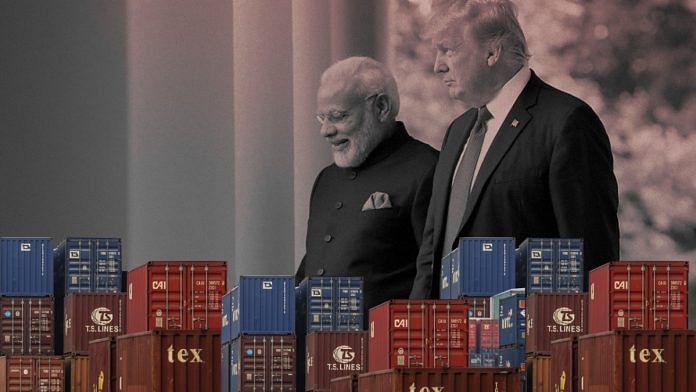President Donald Trump informed the US Congress Tuesday he will terminate preferential trade treatment for India by striking it off the Generalized System of Preferences (GSP) list. He said it was because of India’s “failure” to provide assurances that it will give the US “equitable and reasonable” access to its markets.
ThePrint asks: Is India’s protectionism reason enough for Donald Trump’s GSP move or is US being a bully?
President Donald Trump’s move has neither economic nor strategic rationale
 Arun Singh
Arun Singh
Former Indian ambassador to the US
President Donald Trump’s notification to the US Congress regarding his decision to terminate GSP benefits to India, affecting about $5 billion of India’s exports, has neither economic nor strategic rationale.
Although overall per capita income in India has crossed a certain threshold, a large part of the population is still below the poverty line. GSP benefits in leather, gems and jewellery sectors have gone to the labour intensive industry here, and not negatively impacted the US industry or employment.
Although India has a nearly $30 billion trade surplus with the US, it is nowhere near the $300 billion trade surplus that China has with the US. And India, unlike China, is an overall trade deficit country.
US leaders have repeatedly articulated that they see India’s rise to be in the US’ interest. India’s strategic rise can be firmly anchored only if it is accompanied by an economic rise. The US needs to be a partner in facilitating India’s economic rise and consolidation, and not constrain it.
The US action has clearly been triggered by Trump’s excessive focus on bilateral trade figures and seeking transactional market access gains to project his successes, unmindful of the larger picture.
India also needs to show flexibility and nimbleness in recognising the compulsions of the US presidential politics. Reportedly, China is close to working out a deal with the US, enabling a walking back on the recent mutual tariff enhancements.
In the meantime, India should lobby US Congress to have the move put on hold, despite recent negative sentiments there on account of our e-commerce and data localisation-related measures.
No question of US being a bully because every country makes policies based on own benefits
 Alwyn Didar Singh
Alwyn Didar Singh
Former Secretary General, Federation of Indian Chambers of Commerce and Industry
There is no question of the US being a bully because this is part of their overall policy. Every country formulates policies based on what they reckon is beneficial to them. Under Donald Trump, the US has taken up a strong anti-globalisation stand and implemented protectionist trade policies.
It is time that Indian industries stopped using these crutches to gain trade access. We should strive to be as competitive as we can in the global market. We have been working towards this for a while now, and can only keep persisting. I am certain that India will regain its trade position soon.
It is part of Trump’s policy to not have an “unfavourable balance of trade” with any country. We just have to learn to live with it because the US is following the same set of policies with other countries as well.
In terms of the impact on India, I believe it will be quite marginal because even the non-GSP rates in the US are very low. Moreover, this only covers raw materials and won’t have any impact on higher value items like machine goods and engineering goods. We will continue to access the US market when it comes to those items, as we have in the past.
Escalating trade tensions pose real risks for India-US relationship
 Richard M. Rossow
Richard M. Rossow
Senior Adviser and Wadhwani Chair in US-India Policy Studies, CSIS
The Trump administration on 4 March notified its intent to revoke India’s inclusion in a trade preference programme, the Generalized System of Preferences. On its face, this move is a reasonable response to damaging trade policies adopted by the Narendra Modi government in recent years. Practically, though, escalating trade tensions pose real risks for the India-US relationship.
The Modi government has shown a real reluctance to integrate with the world on trade. India has hiked customs duties, expanded local content rules for government procurement, and adopted new price controls.
However, actual US exports to India have strengthened during this period. Over the last twelve months, American firms exported $32.1 billion in goods to India, up nearly 27 per cent from the prior year. This marks the biggest increase among any of America’s top 15 trade partners.
America has also deepened security ties with India in recent years. We have signed new agreements like COMCASA, new defence export deals, and created a new tri-service exercise that will launch later this year. A wider trade fight could put this positive aspect of our relationship at risk.
Fights happen between friends. But they must be limited, contained, and trigger a serious effort to repair ties.
Considering President Donald Trump’s foreign policy, no action is really proportionate
 Lalit Mansingh
Lalit Mansingh
Former Indian ambassador to the US
While we don’t know what has driven this action, it is definitely a negotiating ploy by the US.
The move won’t cause serious damage to India because it covers only a small fraction of our total trade with the US. That said, what is of course a cause for concern is the US challenging us in this manner. This is despite the fact that India is on the right side of the WTO and is adhering to the regulations. It is definitely a questionable action by the US. I believe when the Office of the United States Trade Representative has its next meeting, this is bound to come up.
Considering President Donald Trump’s foreign policy, no action is really proportionate. Sometimes, his reactions are way out of proportion compared to the issue at hand. For instance, his focus on Harley-Davidson in the India-US trade is quite surprising. It is such an insignificant part of the trade between the two countries that Trump’s repeated reference to the import duty on Harley-Davidson is an overreaction. Similarly, withdrawing India’s GSP designation is also an overreaction.
India should definitely challenge this move because it has strictly adhered to the WTO norms.
Also read: India losing trade battle with China — 80% of two-way business last year were imports
This isn’t the first time the US is arm-twisting another country for its benefit
 Rajeev Kher
Rajeev Kher
Former Commerce secretary and distinguished fellow, RIS
The United States’ Generalized System of Preferences status has been available to us for many years now. Our exports have grown significantly. Now that India is set to be removed from the GSP beneficiaries’ list, the question is whether this was a result of a simple tooth-combing exercise to terminate the designation of every country not deserving of this treatment or was it meant to arm-twist only India.
If it is the first one, then one can have no objection. The US is a sovereign country, it has every right to take this call because GSP, after all, is a unilateral exercise. India should not be seen as seeking a favour because then a situation of quid pro quo will inevitably arise.
The Indian establishment strongly believes in the draft e-commerce policy that it has come out with, and it is the result of a coherent thought process. Data localisation is India’s prerogative.
No country has a right to arm-twist another sovereign country to get a policy orientation of its choice. If the intention behind the US’ move is to make India succumb to a certain kind of policy, then it is condemnable. If that is the case, it wouldn’t be the first time the US is arm-twisting another country for its benefit. Especially under the Trump administration, where everything is transactional.
India needs to dial down its increasingly nationalist policies if it wants US to reconsider
 Prasanto K. Roy
Prasanto K. Roy
Tech writer and policy consultant
Is Donald Trump being a bully? Yes, and short-sighted. But then India has been waving a red rag in front of a bull.
Protectionism and nationalism are the flavours of the season. The US had fired early shots, clamping down on H1B visas and squeezing India’s $126-billion IT exports industry (by a bit: IT-BPM isn’t that dependent on Indian tech workers in the US). India is pushing ahead with increasingly nationalist policies that hurt global players, with new rules for payments, data localisation and e-commerce.
The changes are abrupt, with little room for feedback, forcing global firms like Amazon and Walmart to review investment plans. This abrupt ‘data nationalism’ appears more aligned to the 2019 Lok Sabha elections, and to the needs of domestic corporations entering the digital economy, than to the long-term interests of India and its economy.
Just as with a conflict between two nuclear neighbours, two economic powerhouses heading into a trade war need to de-escalate. But we have a high-stakes election ahead, and the returns on opportunistic nationalism may appear to outstrip returns on the long game for India’s economy.
I’m more optimistic about the US (minus Trump) taking a long-game view of India’s strategic role as a partner in the region, and going back on this move in the next 60 days — but preferably with some reciprocation from India, like dialing down on Swadeshi 2.0 digital policies that go against what the Modi government’s Digital India vision had stood for.
Branding India as a high-tariff country is unfair
 Rajat Kathuria
Rajat Kathuria
Director and Chief Executive, ICRIER
Legally speaking, it is true that India graduated out of Generalized System of Preferences. We don’t fulfil the eligibility criteria for the GSP anymore, as was cited to be the reason.
That said, India being branded as a high tariff country is highly unfair. Our tariffs have come down hugely in the past decades. The rest of the world has moved to a different way of protecting itself. We may still be using high tariffs in certain sectors, but that certainly doesn’t make us a high-tariff country. In fact, this targeting deflects the criticism from other countries, including the US, that are using innovative ways of protecting their markets.
It’s a very narrow way of looking at how protectionism works in today’s day and age.
The trigger for the US’ move was mostly our e-commerce ruling on foreign direct investments, as well as our data localisation policy. Last year, we had capped prices of a number of medical devices as well.
There is of course the likelihood that this won’t carry through or cause us any major threat. In any case, the impact of this on our trade is not likely to be very high.
By Fatima Khan, journalist at ThePrint.



